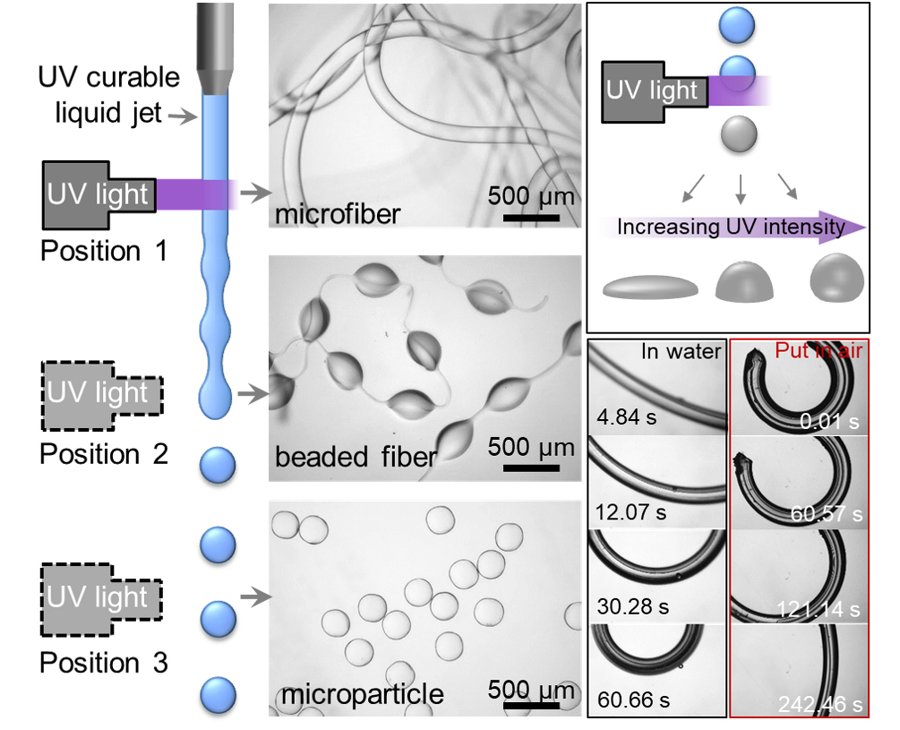Microspheres, microlenses, microfibers: they can now all be produced by irradiating a fluid jet with ultraviolet light. The result is that locally, a polymer of the desired shape is formed. This process called ‘in-air photopolymerization’ enables manufacturing of a wide range of bio-inspired microparticles. The technique is faster than existing techniques and delivers particles of very constant quality. Researchers of the University of Twente present their work in Advanced Materials of 4 December.
Microparticles that stimulate blood circulation or improve vaccine delivery, patches with microneedles that painlessly inject, microfibers attaching themselves to your body, microlenses mimicking insect eyes: in many applications, bio-inspired materials are in high demand. This requires very well-defined building blocks that can be assembled in vast quantities. Still, these manufacturing processes are labour intensive, too slow, difficult to tailor or with too much size deviation. Creating the particles can be done using lab-on-a-chip technology, which is very accurate but not fast, or using chemical etching techniques requiring several processing steps. In their study, the researchers show that it is possible to exactly produce the desired particles, from an ongoing liquid stream. Up to 4000 particles per second.

Depending on the location of the UV irradiation of the liquid jet, fibers, beaded fibers or microparticles are formed.
UV IRRADIATION 'ON THE FLOW'
At first sight, it looks like inkjet printing: a liquid jet comes out of a nozzle, the continuous flow breaks up in droplets. In this case, however, the researchers don’t wait for the liquid to land on a surface, shaping letters or shapes. While the fluid is on its way, they irradiate it with ultraviolet light. At that very spot, the liquid forms a polymer and solidifies.
Jieke Jiang, first author of the paper: “What material we create, is determined by the location. If we illuminate the liquid jet (of polyethyleen glycol diacrylate) while it is still continuous, we can create fibers. If the jet breaks up in droplets, we can make microspheres. Using pulsed light, we can create fibers of a length that is very well determined. Apart from that, we are able to ‘play’ with the chemistry. By adding polyurethane, for example, we can make stronger fibers. We are able to control of all of these properties in a very precise way.”
Janus Fibers
It is even possible to create hollow fibers or ‘Janus fibers’: like the Janus head, with two faces, it combines two materials. This is made possible by illuminating not one but two liquid jets at the same location. Using two materials, active fibers are possible, that will be able to respond to stimuli. The technique, furthermore, shows the capability of creating well-defined microlenses that could enhance the energy efficiency of solar cells or improve the yield of LED displays.

A wide variety of shapes and sizes is possible under highly controlled circumstances
IamFluidics
Earlier on, the UT researchers presented a technique for printing gels, by letting two liquid jets join. Team leader Claas Willem Visser: “We called this ‘in-air microfluidics’, and the polymerization technique we now developed, is a new version of it. The technology led to the IamFluidics company, aiming at sustainable microparticles for pharmaceutics, life sciences and cosmetics, avoiding the use of plastics. On the longer term, we expect it will be possible to use particles for printing living tissue, for tissue engineering for example.”
The research was done in the Engineering Fluid Dynamics group of Prof. Kees Venner, Faculty of Engineering Technology, in collaboration with Harvard Medical School in Boston, USA.
The paper ‘Continuum high-throughput fabrication of architected micromaterials via in-air photopolymerization’, by Jieke Jiang, Gary Shea, Prasansha Rastagi, Tom Kamperman, Kees Venner and Claas-Willem Visser is published in Advanced Materials of 4 December 2020.





